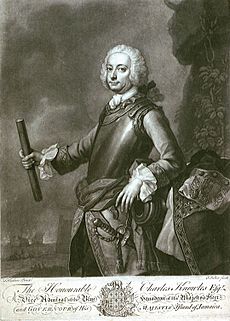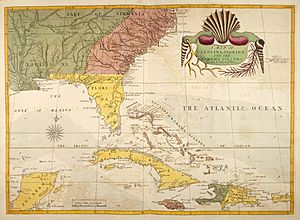William Shirley facts for kids
Quick facts for kids
William Shirley
|
|
|---|---|
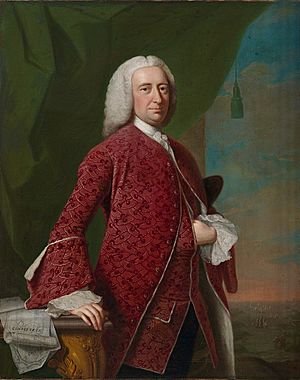 |
|
| 8th and 9th Governor of the Province of Massachusetts Bay | |
| In office 14 August 1741 – 11 September 1749 |
|
| Preceded by | Jonathan Belcher |
| Succeeded by | Spencer Phips (acting) |
| In office 7 August 1753 – 25 September 1756 |
|
| Preceded by | Spencer Phips (acting) |
| Succeeded by | Spencer Phips (acting) |
| Governor of the Bahamas | |
| In office 1760–1768 |
|
| Preceded by | John Gambier (acting) |
| Succeeded by | Thomas Shirley |
| Personal details | |
| Born | 2 December 1694 Sussex, England |
| Died | 24 March 1771 (aged 76) Roxbury, Province of Massachusetts Bay |
| Profession | Barrister, politician |
| Signature |  |
William Shirley (born December 2, 1694 – died March 24, 1771) was an important British official. He served as the governor of the American colonies of Massachusetts Bay and the Bahamas. He is most famous for helping to plan the successful capture of Louisbourg during a war called King George's War. He also played a big role in military matters during the French and Indian War.
Shirley spent most of his time as governor trying to defeat New France, which was the French colony in North America. Even though he didn't have formal military training, he became a key leader. His career had its ups and downs, but he left a lasting mark on colonial history.
Contents
Becoming Governor of Massachusetts
William Shirley was born in England in 1694. He studied law at Cambridge University and became a lawyer. He married Frances Barker, and they had many children. Shirley needed a good job to support his large family. He used his family's connections to powerful people in England to get a position in the American colonies.
In 1731, Shirley arrived in Boston, Massachusetts. He hoped to get a good job from the current governor, Jonathan Belcher. However, Belcher didn't help him much. Shirley eventually became a lawyer for the admiralty court, which handled sea-related legal cases.
Shirley soon became an opponent of Governor Belcher. He joined other people who disliked Belcher. They worked together to get Belcher removed from his job. Shirley's connections in England helped him succeed. In 1741, William Shirley was appointed the new Governor of Massachusetts Bay.
When Shirley became governor, Massachusetts was having money problems. There was too much paper money, which caused prices to go up. Shirley worked hard to fix this. He helped pass laws to make the money system more stable.
Leading During Wartime
As governor, Shirley knew that war with France was possible. He worked to make the colony's defenses stronger. He created special groups of volunteer soldiers, like the famous Rogers' Rangers. These groups helped protect the frontier.
King George's War Begins
In 1744, France declared war on Britain. This war was known as the War of the Austrian Succession in Europe and King George's War in North America. French forces from Louisbourg attacked a British fishing town called Canso in Nova Scotia. French privateers (ships that attacked other ships for profit) also started attacking British and colonial vessels.
Shirley quickly sent soldiers to help defend British areas. He sent troops to Annapolis Royal, which was under attack by the French. Their timely arrival helped break the French siege.
Planning the Louisbourg Attack
A man named John Bradstreet, who had been captured at Canso, told Shirley about the weaknesses of the French fortress at Louisbourg. Shirley and other colonial leaders saw a chance to capture this important French fort.
Shirley brought the idea of attacking Louisbourg to the Massachusetts assembly. At first, they didn't want to support the plan. But after many people pushed for it, the assembly approved the attack by just one vote.
Shirley chose William Pepperrell to lead the expedition. In March 1745, over 4,000 colonial soldiers set sail for Louisbourg. They were joined by British warships.
The Siege of Louisbourg
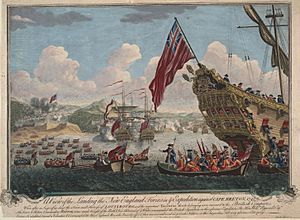
The colonial forces landed near Louisbourg on April 30, 1745. They began to surround the fortress, while the British ships blocked the harbor. The siege lasted for several weeks.
On June 17, Louisbourg surrendered to the British and colonial forces. This was a huge victory for the British colonies. The American soldiers had fought bravely, but they were disappointed that they didn't get any treasure from the captured fort. The British Navy, however, captured many valuable French ships.
After the victory, Shirley traveled to Louisbourg to boost the morale of the soldiers. He promised them better pay and supplies if they stayed. As a reward for the victory, Pepperrell became a special kind of knight called a baronet. Both Shirley and Pepperrell were made colonels in the British Army.
After Louisbourg
Shirley hoped to capture all of New France after the Louisbourg victory. He started planning more expeditions, including one to attack Quebec City. However, the British government decided not to send the support he needed. The expeditions were called off.
This decision made Shirley less popular in Massachusetts. He had also personally gained money from supplying the Louisbourg expedition. He used some of this money to build a large house in Roxbury, which is now known as the Shirley–Eustis House.
Trouble with Sailors
During this time, there was a lot of tension between the British Navy and the people of Boston. The Navy often forced American sailors to join their ships. This was called "impressment" and colonists hated it.
In 1747, a British naval officer named Charles Knowles forced many Boston sailors to join his squadron. A large crowd of over 300 men protested. They seized some naval officers and demanded the release of the impressed sailors.
The crowd went to Governor Shirley's house. Shirley tried to get the local militia to help, but they didn't respond. The mob attacked the Town House, breaking windows. Shirley spoke to the crowd and promised to talk to Knowles. The situation was very tense, but eventually, the impressed sailors were released.
Money Matters and Criticism
Another problem was getting Britain to pay back the American colonies for the costs of the Louisbourg expedition. Shirley faced challenges because some leaders, like his former friend Samuel Waldo, exaggerated their costs.
The British government was slow to pay. Meanwhile, people in Massachusetts debated how to use the money once it arrived. Some wanted to use it to get rid of the paper money and use "hard currency" (like gold or silver).
In 1748, the Treaty of Aix-la-Chapelle ended King George's War. Louisbourg was given back to France, even though Massachusetts had fought hard to capture it. This made many people in Massachusetts very unhappy with Shirley. Newspapers and pamphlets started criticizing him and the British government.
Shirley sailed to England in 1749 to deal with these financial and political issues.
Return to Massachusetts and New Wars
Shirley returned to Massachusetts in 1753. He soon had to deal with growing conflicts with French Canada. Tensions were rising, especially in the Ohio River valley, where British and French traders were clashing.
Shirley quickly organized an expedition to strengthen defenses in Maine. He also attended a meeting of colonies in Albany, New York. He wanted the colonies to unite, but the idea was rejected by most.
The French and Indian War (1755)
The French and Indian War officially began in 1754. Two British Army regiments were sent to America under General Edward Braddock. Shirley met with Braddock and other governors in 1755.
Shirley was given permission to lead his own regiment to attack Fort Niagara. Another expedition, led by William Johnson, was planned for Lake George. Shirley and Johnson had some disagreements, especially about supplies and Native American allies.
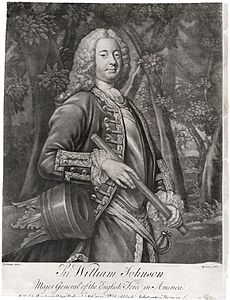
Shirley's expedition to Fort Niagara faced many problems. It was slow and didn't have enough supplies. While on the way, Shirley learned that General Braddock had died in battle. This meant Shirley became the temporary commander-in-chief of all British forces in North America.
Shirley's expedition got stuck at Fort Oswego because its defenses needed improvement. They decided not to go to Fort Niagara that year. Shirley returned to Albany to manage the entire British war effort.
Johnson's expedition also faced challenges. His forces had a battle at Lake George, but it wasn't a clear victory. Many of his soldiers left to go home for the winter.
In Nova Scotia, Governor Charles Lawrence captured Fort Beauséjour. He then began the Great Expulsion, forcing over 12,000 Acadians to leave Nova Scotia. When some ships carrying Acadians arrived in Boston, Shirley ordered them not to leave the ships. Many Acadians died from cold and hunger during the winter.
Challenges and Recall (1756)
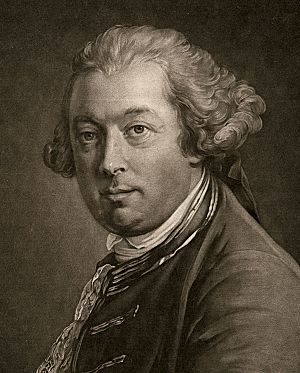
Shirley's disagreements with William Johnson continued. Johnson and other New York politicians sent negative reports about Shirley to London. Shirley didn't know his authority was in danger.
Shirley made big plans for the 1756 war season. However, the complaints against him reached the Duke of Newcastle in England. British leaders decided Shirley was too involved in arguments with other leaders. They also worried because Shirley had married a French woman.
In April 1756, Shirley learned he would be replaced as commander-in-chief. He worked hard to send supplies and help to the soldiers at Fort Oswego. But his authority was weakening. Fort Oswego fell to the French in August 1756.
Shirley was still the governor of Massachusetts, but he expected to lose that job too. He argued with the new commander, Lord Loudoun, about war expenses. Shirley gathered evidence to support his actions. He sailed for England in October 1756. He was officially replaced as governor in 1757.
Later Life and Legacy
When Shirley arrived in London, he found that his main supporter, the Duke of Newcastle, had lost his job. Shirley's arguments with Lord Loudoun meant he probably wouldn't get another job in North America.
However, the British military continued to do poorly in North America. This made Shirley look better, and he regained some favor with Newcastle.
In 1758, Shirley was appointed Governor of the Bahamas. He arrived there in December, after his ship was wrecked on a reef, but he was unharmed. His time as governor was peaceful. He mainly dealt with smugglers and worked to make Nassau a free port for trade. He also oversaw repairs to the governor's house and helped build churches.
In 1765, his wife died. He took his children to England to be cared for. When he returned to the Bahamas, he faced protests against the new Stamp Act. He dissolved the local assembly because of their strong opposition. The Stamp Act was later canceled.
Shirley's health began to fail. His son, Thomas, replaced him as governor in 1767. Shirley then sailed back to Boston. He lived in his old house in Roxbury with his daughter and son-in-law.
William Shirley died on March 24, 1771. He had a state funeral and was buried in King's Chapel in Boston.
Family and Lasting Impact
Shirley had two sons and three daughters. His elder son, Thomas, became a major general in the British army and later a baronet. He also served as governor of other colonies. Shirley's other son, William Jr., died in battle in 1755.
The house Shirley built in Roxbury between 1747 and 1751 is now known as the Shirley–Eustis House. It is a museum open to the public.
The town of Shirley, Massachusetts was named after him during his time as governor. Shirley Point in Winthrop, Massachusetts is also named for him.
Images for kids
-
Engraved portrait of Jonathan Belcher
-
William Pepperrell, portrait by John Smibert
-
Shirley's patron, the Duke of Newcastle; c. 1730s portrait by Charles Jervas
-
Brigadier-General Samuel Waldo, late 1740s portrait by Robert Feke
-
The Shirley–Eustis House, in Roxbury, now part of Boston
See also
 In Spanish: William Shirley para niños
In Spanish: William Shirley para niños


